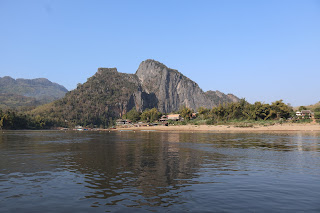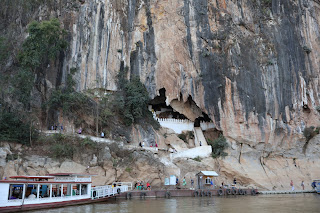Near Pak Ou (mouth of the Ou river) the Tham Ting (lower cave) and the Tham
Theung (upper cave) are caves overlooking the Mekong River, 25 km to the north
of Luang Prabang, Laos.
They are a group of two caves on the west side of the Mekong river, about two
hours upstream from the centre of Luang Prabang, and are frequently visited by
tourists.
The caves are noted for their miniature Buddha sculptures. Hundreds of very
small and mostly damaged wooden Buddhist figures are laid out over the wall
shelves. They take many different positions, including meditation, teaching,
walking, naga, peace, rain, and reclining (Nibbana).
Reaching the caves
|
Embarking to the other bank of the Mekong River.
The boat departs from Pak Ou village on the east bank of the river and
heads to the Pak Ou caves on the west bank of the river.
|
|
Appreciating the impressive Pha Hen limestone cliff.
During the crossing we can appreciate the impressive limestone cliff
called Pha Hen located at the mouth of the Nam Ou river, on the opposite
side of the Pak Ou caves.
|
|
Receiving information about Pak Ou caves.
The boat crossing is the ideal time to receive information about the Pak
Ou caves from the local guide.
|
|
The lower cave is entered from the river.
The lower cave, known as Tham Ting, is entered from the river by a
series of steps and can easily be seen in daylight.
-
Stairs to the left of Tham Ting lead around to the upper cave, Tham
Phum, which is deeper and requires artificial light for viewing – be
sure to bring a torch (flashlight) if you want to see both caves.
|
|
Pak Ou (Ting) Cave Map.
At the boarding pier there is this map that provides guidance on the
location of the caves.
|
|
Climbing the stairs towards the lower cave.
The lower cave is located to the north, and the upper cave is located to
the west.
|
Southern section of the lower cave
|
Entering the southern section of the lower cave.
The lower cave is made up of two sections. The southern section is
located on the left side of the stairs. The northern section is located
on the right side of the stairs.
|
|
Entrance to the southern section of the lower cave.
The entrance to the southern section of the lower cave is guarded by two
lions, one on each side of the entrance.
|
|
Lion dominating the southern section of the lower cave.
Shortly after the entrance, on the right side, another lion dominates
the entire southern section of the lower cave.
|
|
Hermit sage Ruesi.
Ruesi is a hermit sage, the equivalent of Rishi in India. In Indian
religions, a rishi is an accomplished and enlightened person.
-
Rishi Akkhata, known as Phra Reusi Akkhot in Thailand, is an important
Ruesi in Southeast Asia, as in the Buddhist Jataka scriptures, this
Ruesi is mentioned as the bodhisatta and practiced his ascetism in Sri
Lanka and Southeast Asia.
-
Veneration of Ruesis is a notable practice in Southeast Asian
Buddhism.
-
See more at
Ruesi in Cambodia, Thailand, Myanmar and Laos - Wikipedia.
|
|
Buddhist altar.
The main area of the southern section of the lower cave is occupied by
an altar with Buddha statues. Prayers and offerings are made at this
altar.
|
|
Altar of the cave spirit.
Behind the Buddhist altar is the cave spirit altar.
-
The Buddhist altar is on the right side of the photo, and the grotto
spirit altar is in the center of the photo in the back plane.
|
|
Shrine of the cave spirit.
The entrance to the cave spirit shrine is on the right side of the
photo.
-
Above the entrance there are bells for us to announce our presence.
|
|
Statue of the cave spirit.
|
|
Questioning the cave spirit.
To ask questions to the cave spirit we use Chien Tung sticks.
-
Kau chim, kau cim, chien tung, "lottery poetry" and Chinese
fortune sticks are names for a fortune telling practice that
originated in China in which a person poses questions and interprets
answers from flat sticks inscribed with text or numerals.
-
In Thailand, kau chim is commonly known as
seam si (alternatively spelled siem si,
siem see).
-
The papers contain lyrical notes that describes your life at the
present time with the purpose of helping you reflect on how you can be
better. It is important to highlight that despite the name, the papers
do not actually predict your fortune or future.
-
The tradition is very similar to o-mikuji, which is practised
at Japanese shrines with the key difference being that
o-mikuji is more superstitious and is purchased with money.
-
See more at
Kau chim - Wikipedia
and
O-mikuji - Wikipedia.
|
|
Towards the edge of the southern section.
Walking towards the edge of the southern section of the lower cave.
|
|
View of Pha Hen cliff.
View of Pha Hen cliff from the end of the southern section of the lower
cave.
-
The silhouette formed by the rocks simulates a person on each side of
the photo.
|
|
View of the main area of the southern section of the lower cave.
This photo is taken from the Buddhist altar towards the northern section
of the lower cave.
-
In the center we can see the entrance to the southern section with the
two lions.
- On the right side is the staircase that leads to the river.
-
In the upper left corner of the photo is the northern section of the
lower cave.
|
Northern section of the lower cave
|
General view of the northern section of the lower cave.
The northern section of the lower cave is arranged on several levels.
- Only the lower levels are accessible to the public.
|
|
Northern section of the lower cave.
The northern section of the lower cave is crammed with Buddha images of
all styles and sizes (but mostly classic Luang Prabang standing
Buddhas).
|
|
Hundreds of wooden Buddhist figures.
Hundreds of very small and mostly damaged wooden Buddhist figures are
laid out over the wall shelves.
-
They take many different positions, including meditation, teaching,
walking, naga, peace, rain, and reclining (Nibbana).
|
Leaving the caves
|
Going down the stairs towards the river.
|
|
View from the other bank of the river.
|
|
Appreciating once again the impressive Pha Hen limestone cliff.
|
|
Going down the Mekong.
Now we go down the Mekong from the Pak Ou caves to Luang Prabang.
|
|
Enjoying a cocktail while cruising along the Mekong.
|
|
Enjoying the sunset while cruising along the Mekong.
|
|
Leaving the boat in Luang Prabang.
|
See also
Source
Location
Xang Hai Village (Whiskey Village)
Pak Ou Village (Mouth of the Ou River Village)
Alms Giving Ceremony
Morning Food Market















































